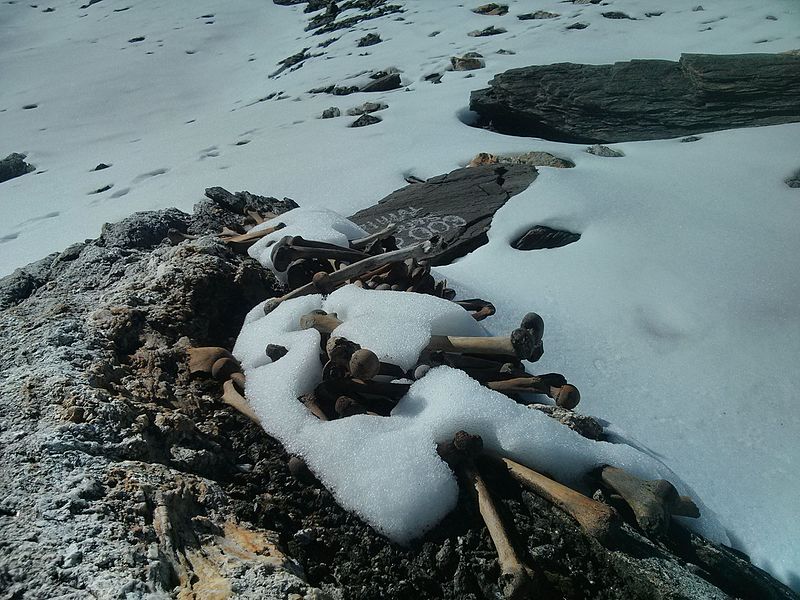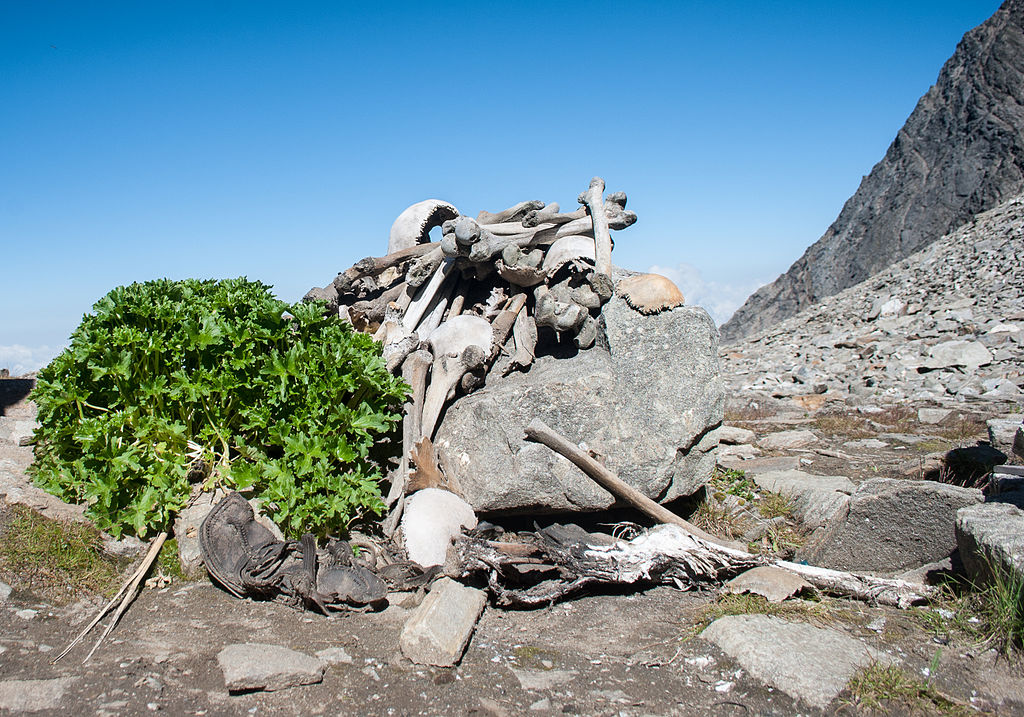Roopkund: Skeleton Lake
Welcome on this Weird Wednesday! Today we’re off to the Indian Himalayas to check out a lake that people are just dying to visit. Literally.
Sometime in the past 1200 years or so, several hundred people have died at the isolated, high-altitude Roopkund lake. How do we know? They’re still there.
Also known as “Skeleton Lake,” Roopkund is famous for having shores littered with the scattered bones of at least 300 people (see pic, above). Who were they? How did they die and when? Unfortunately, nobody knows for sure. But there are some clues.
At first, people wondered if the skeletons might belong to a doomed army marching through the mountains, but the remains include women and children, and few weapons. There aren’t many elderly people whose presence might suggest the lake was used as a graveyard, and their bones show no sign of an epidemic disease that could have wiped out hundreds at once. Instead, the clothing and artifacts found with the bones suggest they belong to pilgrims on a holy voyage, and indeed, Roopkund is near several Hindu pilgrimage sites.
But how did they all die? Oddly enough, some of the bones show signs of blunt trauma. And there is a local legend that tells of a large party of pilgrims who angered the goddess Nanda Devi, who punished them with a hailstorm. Hail is common in the area, so it makes perfect sense: the legend is preserving a real weather event that killed hundreds.
Except recent DNA analysis and other scientific studies suggest something far stranger.
To start with, the dead at Roopkund actually represent two distinct time periods. The oldest are from 800 CE, and contrary to the legend, these folks don’t seem to have died in a single cataclysm, but over a period of years. DNA marks them as locals, and it’s likely they were pilgrims who died a few at a time, from perfectly explainable causes. Roopkund is in the high Himalayas, sparsely populated because of its wicked weather (blizzards and yes, hail) and high altitude: 16,470 feet.
(For comparison, the “death zone” of Everest and other mountains starts at 26,000 feet. At that elevation, there isn’t enough oxygen to sustain human life. The villages near Roopkund are all below the site of the lake.)
So that’s not so strange, really. The old legend is probably still based in fact, but there was no one hailstorm that wiped out hundreds. Just a few people at a time who died from weather, possibly hail, and/or altitude sickness. Mystery solved.
Except that doesn’t explain the more recent skeletons at the lake. These folks, probably numbering in the hundreds, are from around 1800 CE. Only two hundred years ago. That’s far too late to feature in the old legend. And that is bizarre, because these people really did all die together, in some single cataclysm on the shores of Roopkund.
That’s not even the strangest part! It turns out these people are from the Mediterranean, around Crete. Not the typical folks to be on a Hindu pilgrimage in the Himalayas. Who were they? What on earth were they doing there? Why don’t the locals have a story about a bunch of foreigners dying in some disaster at the lake?
Nobody knows. But for our purposes, that’s all right, because we’re going to turn this tale fictional with some mysterious writing prompts!
- The unquiet dead. The most obvious prompt here is a ghost story. People with unsolved deaths and unburied bones are good sources for ghosts. There are a couple of ways to go here: you could have ghosts who simply want their story known, ghosts who are vengeful and strike out against visitors, or ghosts who just like chilling (pun intended) at the isolated lake and don’t want to be disturbed. Of course, humanity being what it is, visitors have greatly disturbed the bones at Roopkund, moving them around and carting them off. That’s a real-world problem for archaeology, and a fictional problem if you’ve got ghosts attached to those bones.
- Disaster movie. Bring on the hailstorms. What could have killed so many people all at once? You can set your story anywhere, so the possibilities are wide open. Deadly natural disasters include blizzards, wildfires, tornadoes and hurricanes, volcanoes, earthquakes, and even lightning. Some of those would leave evidence on bones, and some would not. Some lakes in particular (though not Roopkund) can release clouds of deadly carbon dioxide in a limnic eruption, suffocating anybody nearby. Or you could have unnatural disasters like monsters, aliens, or angry gods. Perhaps the lake is cursed. Maybe newer visitors find themselves standing on a field of bones, and have the awful realization they’ll probably be joining them.
- Visitors from another realm. Just when you think you understand what happened in the past, a new find changes everything. It’s especially unsettling when the evidence consists of human remains. You could write just that kind of mystery about our planet or a fantasy world, where scientists discover foreign travelers in a strange place, or evidence of ancient contact between two peoples long before they were thought to have met. Explanations could include voyages of exploration or just people getting lost, or less realistic ideas like teleportation, tunnels through the center of the earth, alien abductions that return people in the wrong place, or magic.
- Conspiracy theory. You could pen a political thriller about a skeleton lake. Perhaps the bones belong to a lost army whose story was hushed up by some government, but whose families have never given up the search. Or the bones could be from prisoners of war or abductees, or people fleeing conflict into inhospitable mountains. Or maybe two countries are fighting over a shared border, and the discovery of human remains might show who got there first. Governments could also argue over whose citizens were the first to climb a certain mountain or discover some natural wonder. In all cases, a government might have reason to conceal or destroy remains they find, and your protagonist could fight to expose the truth.
- Walking on history. What if the lake wasn’t isolated? Maybe it’s a favorite vacation spot, enough that people are always building new lodges and hotels. Only when they break ground in a certain spot, they find a field of bones. Is it a lost cemetery? The site of an ancient battle? A mass grave for disease or war victims, maybe hushed up by the government? Or you could have a Roopkund-like mystery, with the bones belonging to people from far away on an undocumented trip. Or maybe, when the DNA comes back, it turns out they aren’t human bones at all…
Thanks for spending your Weird Wednesday here! When you leave, please remember to take your bones with you.
Want to chat about the blog? Did you use one of the prompts? Hit me up on social media.
If you like stories about mysterious skeletons, you can read my story The Lifeboat in Seaside Gothic, Issue 4. Cousins looking to scatter their grandfather’s ashes make an unsettling discovery in a sea cave.
Sign up for my free monthly newsletter and never miss a blog post! Or subscribe by RSS
A remote Himalayan lake holds up to 800 skeletons: Business Insider
The Skeletons at the Lake: The New Yorker
Roopkund: Wikipedia
Harney É, Nayak A, Patterson N, et al. Ancient DNA from the skeletons of Roopkund Lake reveals Mediterranean migrants in India. Nat Commun. 2019;10(1):3670. Published 2019 Aug 20. doi:10.1038/s41467-019-11357-9 https://www.ncbi.nlm.nih.gov/pmc/articles/PMC6702210/


